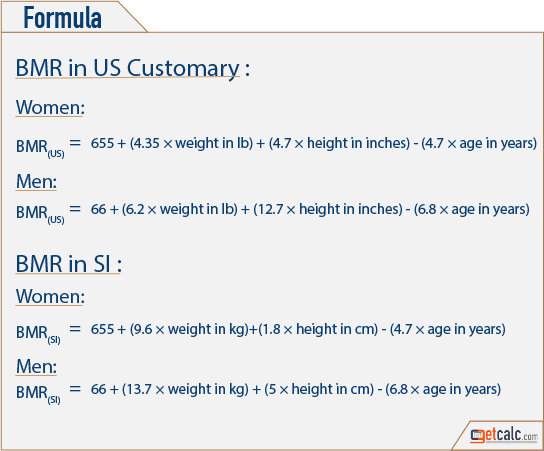

These include The Mifflin-St Jeor equation, the Harris-Benedict equation, and the Katch-McArdle equation.

There are several different formulas that have been developed over the years to calculate BMR. On the other hand, older individuals generally have lower calorie needs due to decreased lean body mass and changes in hormones that play a role in metabolism. All of these individual factors play a role in how much energy your body uses at rest.įor example, men tend to have more lean muscle mass than women, which raises their basal metabolic rate. Your BMR will be based on your height, weight, age, and gender. Since it is not possible for the majority of people to do indirect caloremitry, a number of equations have been created to try to provide the best estimate of basal metabolic rate. However, there are limitations to indirect calorimetry, such as cost and accessibility, that make it not possible for most people to do. These labs measure the heat coming off of your body to determine the number of calories that it burns at rest. The only way to determine your true BMR would be to go to a lab and have your metabolic rate measured by gas analysis through either direct or indirect calorimetry.

This represents the energy, or calories, that your body requires to function when completely at rest and includes all of your normal bodily functions, such as your respiration, your heart rate, blood flow, and brain activity.īasically, all of the vital functions that keep you alive!Įveryone will have a different BMR since this is dependent on your height, weight, age, and gender.
#Bmr female update
The paper behind the latest update (Mifflin et al) to the BMR formula states all participants in their study fall within the 'normal' and 'overweight' body mass index (BMI) categories, and so the results also do not necessarily apply to those in the 'underweight' or 'obese' BMI categories.Your basal metabolic rate (BMR) is your resting metabolism. As muscle and fat require differing amounts of calories to maintain, the TEE estimates will not be accurate for such cases. Later work produced BMR estimators that accounted for lean body mass.Īs the BMR equations do not attempt to take into account body composition, identical results can be calculated for a very muscular person, and an overweight person, who are both the same height, weight, age and gender. published an equation more predictive for modern lifestyles in 1990. The Harris-Benedict equation sprang from a study by James Arthur Harris and Francis Gano Benedict, which was published in 1919 by the Carnegie Institution of Washington in the monograph A Biometric Study Of Basal Metabolism In Man. The Harris–Benedict equations revised by Mifflin and St Jeor in 1990: MenīMR = (10 × weight in kg) + (6.25 × height in cm) – (5 × age in years) + 5īMR = (10 × weight in kg) + (6.25 × height in cm) – (5 × age in years) – 161 The 95% confidence range for men is ☒13.0 kcal/day, and ☒01.0 kcal/day for women. The Harris–Benedict equations revised by Roza and Shizgal in 1984.

The original Harris–Benedict equations were published in 19. The Harris-Benedict equation may be used to assist weight loss - by reducing the kilocalorie intake number below the estimated maintenance intake of the equation. The estimated BMR value may be multiplied by a number that corresponds to the individual's activity level the resulting number is the approximate daily kilocalorie intake to maintain current body weight. The Harris–Benedict equation (also called the Harris-Benedict principle) is a method used to estimate an individual's basal metabolic rate (BMR). Method used to estimate an individual's basal metabolic rate


 0 kommentar(er)
0 kommentar(er)
